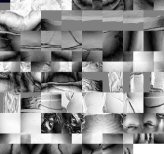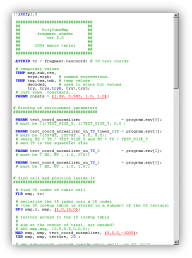Include PolyCubeMapped models in your application
It is very easy to include in your application a model textured with a PolyCubeMap.
Basically
it is as easy as to include a standard texture mapped model.
Just follow three steps:
(No, the vertex shader does not need any change. The fixed functionality one is just fine.)
To let you test PolyCubeMap right away, we included a few downloadable
examples of PolyCubeMapped models at the bottom of this page.
If anything is going wrong, you may check the troubleshooting section.
[back to main PolyCubeMap page]
Loading the fragment program.
You will need the fragment program below.
It is a plain ascii file. In your program, read it from the disk into a string.
Then, after initializing OpenGL, build a new fragment program (with glGenProgramsARB),
bind it (glGenProgramsARB with
GL_FRAGMENT_PROGRAM_ARB as parameter) and load the string into it,
for example glProgramStringARB( GL_FRAGMENT_PROGRAM_ARB,
GL_PROGRAM_FORMAT_ASCII_ARB, strlen(text), text).
After loading it, you have got to let the program know about some parameters, that will reflect
the 2D texture size that you will be using (in texels), and the size of texture ``squarelets''
(the squared 2D texture regions that store the surface of a quarter of a polycube face - again,
see the paper for details).
We set these parameters implicitly, using them to compute appropriate formulas,
and using the results to asign some Program Environment Parameters.
You don't have to worry about the details, here is a C doing everything.
void ParameterizeShader(int textSizeX,
int textSizeY,
int squareletSize) {
double
d0x = 1.0 / textSizeX ,
d0y = 1.0 / textSizeY ,
d1x = 255.0 * squareletSize / textSizeX ,
d1y = 255.0 * squareletSize / textSizeY ,
d2x = 1.0 * squareletSize / textSizeX ,
d2y = 1.0 * squareletSize / textSizeY ;
glProgramEnvParameter4dARB( GL_FRAGMENT_PROGRAM_ARB, 0, d0x,d0y,0,0 );
glProgramEnvParameter4dARB( GL_FRAGMENT_PROGRAM_ARB, 1, d1x,d1y,0,0 );
glProgramEnvParameter4dARB( GL_FRAGMENT_PROGRAM_ARB, 2, d2x,d2y,1,0 );
glProgramEnvParameter4dARB( GL_FRAGMENT_PROGRAM_ARB, 3, d2x,d2y,1,1 );
};
And don't forget to enable the fragment program:
glEnable(GL_FRAGMENT_PROGRAM_ARB);
Note that there are four alternative endings in the fragment program above.
Select the one suiting your tastes, uncommenting it.
The first one (on by default) is a plain copy of the final texture value on the screen - useful for example
when the texture maps encodes pre-shaded gray levels. The second one blends the texel color
with the original fragment color (that may encode for example the shading).
The last two are just for illustration purposes: the third blends in a color that codes the current cell
configuration, and the fourth also highlights cell borders.
Of course there are much more things that you may want to do with the final texel value. Just to name one, in a
normal-map polycube maps the texel would encode a normal value, that must be shaded accordingly, and so on. Implementing
these is up to you...
[back to top]
Loading the PolyCubeMap image.
|
You load the PolyCubeMap image in the same way you load any other
texture image. We provide here some example PolyCubeMap images and models. Get them at the bottom
of this page.
Remember, a PolyCubeMap is stored in the texture memory
as a flattened polycube 2D image, that stores the
final texture values, plus a tiny lookup table that in practices stores the polycube layout.
The latter can optionally be serialized and kept in a subpart of the former (instead of keeping
it in a tiny separate texture).
This is the case for the texture images provided here (and the fragment shader above
knows about this). So all you have to do is to load the a single png image and store it in texture space
as normal. Don't forget to bind the texture and to activate it. Also,
remember to set both the minification and magnification filters to a plain CLOSEST, leave that to
the shader.
|

|
Displaying the mesh.
Again, you do that just as you normally would for a textured object. You can use anything:
triangles, quads, triangle strips, fans, point clouds, display lists and so on.
Just be sure to send,
along with each vertex, its 3D texture coordinates (actually, the possibility to set
them uniquely per-vertex is one of the neat feature of PolyCubeMaps). For example,
to send a single textured triangle of a mesh, just use:
glBegin(GL_TRIANGLES);
glTexCoord3dv( tc[i] );
glVertex3dv( v[i] );
glTexCoord3dv( tc[j] );
glVertex3dv( v[j] );
glTexCoord3dv( tc[k] );
glVertex3dv( v[k] );
glEnd();
where v and tc are the arrays containing
the vertices position and the 3D texture coordinates respectively, and
i,j,k are the three indices of the vertices
composing the triangle. It's as simple as that.
Below, you will find some triangle meshes that can be used as a test. Each of them has one (or more)
corresponding PolyCubeMaps images.
The format, an ascii ply file, should be quite self explanatory:
after the header, you will find a plain series of vertices, followed by a series of faces.
Each separate vertex or face is on a single line. A vertices is represented by it position
(three real numbers), followed by its texture coordinates (other three real numbers). A face
is plainly a number of sides (always "3" here, they are triangle meshes) followed by the
three indexes of the vertices of that face.
[back to top]
Ready to Use PolyCubeMapped Models
[back to top]
Troubleshooting
If you are experiencing any problems, you can check this list:
- Does not compile: did you include extgl.h?
- Mesh is black: maybe fragment programs are not supported.
You can check, for example, by looking at the value of extgl_Extensions.ARB_fragment_program
after the call to extgl_Initialize(). Also, maybe the fragment program is too demanding for your
card (unlikely: if fp are supported at all, there should be enough resources for this fp). Either way, you need a new card
or at least new drivers if you want to run this fragment shader.
- Strange looking texture: the problem could be in the lookup table;
the texture must be loaded with 8 bit per channel, and must not
be compressed .
This is because potentially every bit counts in the lookup table, and compressing
the texture that embeds it can be harmful.
Try changing the OpenGL settings so that the delivered texel depth is the one required, and so that
texture compression is not used. (For some weird reason, on a specific laptop card we experienced that this problem
would go away if the texture was loaded twice in memory. Go figure.)
- Strange looking texture: make sure that both minification and magnification
filters are set to CLOSEST.
- Strange looking texture: maybe you are loading the png file upside down.
This happens a lot, it seems that human kind is unable to make up his mind about which direction the y axis should
point. Depending on which library you are using to load the image, you might need to invert the image buffer.
For a test, check this: in the 1st Laureana texture, the 1st rgb value in the buffer should be (0,1,205). If it
is (159,159,159), you are having your texture upside down.
[back to top]






 Meshes
Meshes